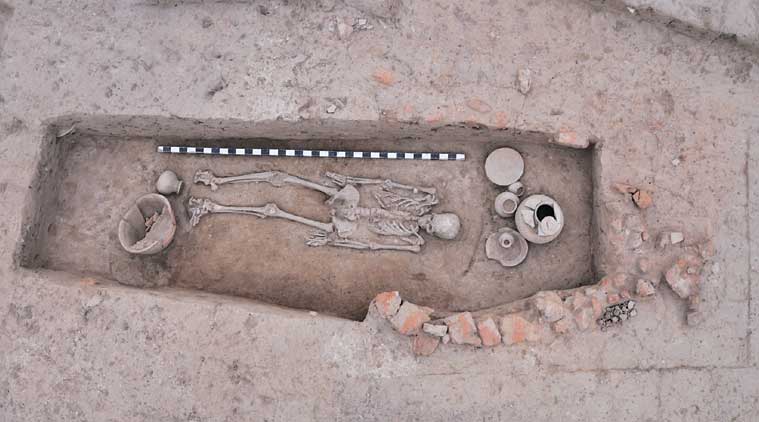According to Archaeological Survey of India (ASI) officials leading the project, the latest round of excavations at the 5,000-year-old Harappan site of Rakhigarhi in Haryana’s Hisar has revealed the structure of some houses, lanes and a drainage system, and what could possibly be a jewellery-making unit.

Consider the following discoveries and what they signify for our understanding of the site:
SKELETAL REMAINS
Two women’s remains were discovered at Mound No. 7 of Rakhigarhi, which is thought to be almost 5,000 years old. ASI authorities claimed pots and other artefacts were discovered buried near to the bones, possibly as part of burial ceremonies. DNA samples were sent for testing, and the results might reveal information about the ancestry and eating habits of individuals who lived thousands of years ago in the area. In earlier excavations, the mound had revealed roughly 60 graves.
The DNA study, according to S K Manjul, the excavation team’s head, will assist answer a number of problems, anthropological and otherwise. Before the materials are transported overseas for additional forensic investigation from an anthropological standpoint, Birbal Sahni Institute of Paleosciences in Lucknow will conduct preliminary scientific testing.
SIGNS OF SETTLEMENT
This is the first time excavations have been carried out on Mound No. 3 at Rakhigarhi, which has uncovered what looks to be a “aristocratic community,” according to ASI authorities. More rounds of excavation will be required to determine the structure and character of the site. There have been comparable indicators of three tiers of occupancy in all Harappan sites unearthed so far: ‘common villages’ with mud brick walls, ‘elite settlements’ with burned brick walls beside mud brick walls, and possible’middle-rung settlements.’
Researchers are still trying to figure out if these three categories were determined by community or occupation. When excavations at Mound No. 3 continue in September, more clues may emerge.
ARTEFACTS
Steatite seals, terracotta bangles, clay unbaked sealing with relief of elephants, and the Harappan script are among the other notable artefacts. The team also discovered several Harappan sealings (the impression of a seal on a surface), demonstrating that seals were used to indicate artefacts belonging to a group of people or community, as they do today, according to Arvin Manjul, Regional Director (North), ASI.
The 1,000 or so artefacts discovered this season are from the mature Harappan era, according to her. The Harappan Civilisation is split into three phases archaeologically: early (3300 BC to 2600 BC), mature (2600 BC to 1900 BC), and late (2600 BC to 1900 BC) (1900 BC to 1700 BC). Mohenjo-Daro, Harappa, Ganweriwala (both in Pakistan), and Rakhigarhi and Dholavira (all in India) have been recognised as the Civilisation’s centres.
JEWELLERY UNIT
According to Disha Ahluwalia, a PhD scholar at the Maharaja Sayajirao University of Baroda who is part of the excavation team in Rakhigarhi, a great number of steatite beads, semi-precious stone beads, shells, and agate and carnelian artefacts have been recovered. Three of the seven mounds are now being excavated, and fragments of copper and gold jewellery have been discovered.
The ruins of a 5,000-year-old jewelry-making unit have been discovered, implying that commerce took place in the city, according to ASI authorities. Because the location lacked a quarry for stones like lapis lazuli or shells, Manjul believes the discovery demonstrates substantial trading from as far away as Afghanistan, where lapis was discovered.
